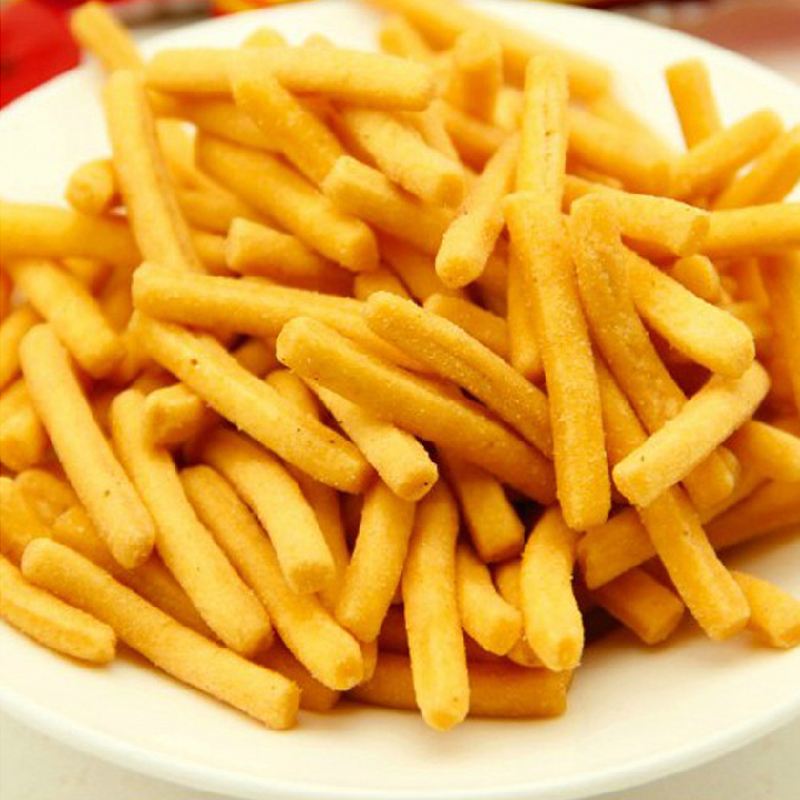About the development trend of puffed food
For a long time, puffed food has been welcomed by many consumers because of its good palatability, unique and diverse taste, easy to carry, convenient to eat, and long shelf life. However, in recent years, puffed food has been repeatedly criticized for its nutritional safety and other factors, which has seriously restricted its healthy development. Analyze the current situation and future development.
 Nutritious cereal puffed food. Fats, carbohydrates and proteins are the main components of traditional puffed foods. From the perspective of composition, it is a high-fat, high-calorie, low-fiber food. In addition, most of the traditional puffed snacks contain more monosodium glutamate, salt and food additives. Long-term consumption of a large amount will lead to high fat and calorie intake, insufficient nutrient intake, and easily lead to obesity. With the gradual improvement of people's consumption awareness, food nutrition has become the main focus of consumers' shopping. As puffed food, the most important issue in the current industry development is to solve the nutrition of the product and change people's previous understanding of their "junk food". From the perspective of composition structure, traditional puffed cereal food is a kind of high-fat, high-calorie, low-crude fiber food. Long-term consumption will lead to high fat and calorie intake and insufficient nutrient intake, which can easily lead to obesity. Therefore, low energy quantification is also an important development direction of snack food.
Nutritious cereal puffed food. Fats, carbohydrates and proteins are the main components of traditional puffed foods. From the perspective of composition, it is a high-fat, high-calorie, low-fiber food. In addition, most of the traditional puffed snacks contain more monosodium glutamate, salt and food additives. Long-term consumption of a large amount will lead to high fat and calorie intake, insufficient nutrient intake, and easily lead to obesity. With the gradual improvement of people's consumption awareness, food nutrition has become the main focus of consumers' shopping. As puffed food, the most important issue in the current industry development is to solve the nutrition of the product and change people's previous understanding of their "junk food". From the perspective of composition structure, traditional puffed cereal food is a kind of high-fat, high-calorie, low-crude fiber food. Long-term consumption will lead to high fat and calorie intake and insufficient nutrient intake, which can easily lead to obesity. Therefore, low energy quantification is also an important development direction of snack food.
Many puffed cereals have a frying process, so their energy control is closely related to their oil content, which is determined by the absorption of oil during processing. Selecting ingredients with high solids content can shorten the time required for frying, or pre-drying or partially drying ingredients prior to frying to shorten frying time. In order to control the amount of oil absorbed during frying, frying temperature is also critical. The ingredients should be fried at the highest possible temperature to shorten frying time and reduce oil absorption. In addition, the larger the surface area of the raw material, the more oil is absorbed. Therefore, the oil content of the wafer is low. Microwave puffing refers to the radiation conduction of electromagnetic energy, so that water molecules absorb microwave energy, generate rapid molecular vibration to obtain kinetic energy, realize the gasification of water, and then drive the overall puffing of the material. At present, there are cereal puffed foods produced by microwave puffing technology, such as microwave popcorn in the United States.
Compared with the snack food made by frying and puffing, microwave puffing has low oil content, no oil or less oil, crispy and delicious, and has the characteristics of fast heating speed, short time, high product quality, uniform heating and small equipment footprint. It is foreseeable that microwave puffing technology is a development direction of puffed food production technology. Since the basic research and equipment development of microwave puffing application in my country is still in its infancy, microwave puffing technology still needs further research and development.
Grain is the main food resource for human survival, and the grain processing industry shoulders the heavy responsibility of providing basic dietary sources and ensuring human health. At present, the world's grain processing industry is developing in the direction of utilizing modern high technology, developing limited grain resources and increasing the added value of grain products. At present, the production of puffed food by puffing technology in my country is still in its primary stage, and the research on puffing theory and puffing technology should be actively carried out, and new products should be continuously developed. It is believed that with the development of the above work and the improvement of people's living standards, puffed food that meets people's living needs will develop rapidly.




